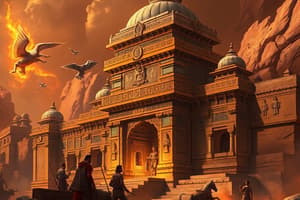Podcast
Questions and Answers
Who founded the Gupta Empire?
Who founded the Gupta Empire?
- Chandragupta II
- Ashoka
- Chandragupta I (correct)
- Vikramaditya
What was the system of governance in the Gupta Empire?
What was the system of governance in the Gupta Empire?
- Decentralized administration with power divided between central government and local authorities (correct)
- Feudal system with powerful nobles
- Bureaucratic system with a strong prime minister
- Centralized administration with a strong king
What was the medium of exchange used in the Gupta Empire?
What was the medium of exchange used in the Gupta Empire?
- Gold coins (correct)
- Copper coins
- Barter system
- Silver coins
What was the impact of the Gupta period on Hinduism?
What was the impact of the Gupta period on Hinduism?
What was a major hub of agricultural production in the Gupta Empire?
What was a major hub of agricultural production in the Gupta Empire?
What was a significant advancement in technology during the Gupta period?
What was a significant advancement in technology during the Gupta period?
What was a major export of the Gupta Empire?
What was a major export of the Gupta Empire?
What was a characteristic of Gupta art and architecture?
What was a characteristic of Gupta art and architecture?
Flashcards are hidden until you start studying
Study Notes
Gupta Empire
- The Gupta Empire was an ancient Indian empire that existed from approximately 320 to 550 CE.
- It was founded by Chandragupta I, who ruled from 320 to 335 CE.
- The empire reached its peak during the reign of Chandragupta II (380-415 CE), also known as Vikramaditya.
- The Gupta Empire was marked by a period of relative peace and stability, often referred to as the "Golden Age" of ancient India.
Gupta Administration
- The Gupta Empire was divided into provinces, each governed by a governor or viceroy.
- The administration was decentralized, with power divided between the central government and local authorities.
- The Gupta rulers issued gold coins, known as dinars, which were used as a medium of exchange.
- The empire maintained a strong and efficient administrative system, with a well-organized bureaucracy.
Society And Culture
- The Gupta period saw a resurgence of Hinduism, with the rise of the Bhagavata and Vishnu cults.
- Buddhism and Jainism also flourished during this period.
- The Gupta era saw significant advancements in education, with the establishment of universities such as Nalanda and Takshashila.
- The period was marked by a growth in literature, art, and architecture, with the development of Sanskrit as a literary language.
Economic Developments
- The Gupta Empire was a major center of trade and commerce, with trade routes extending to the Mediterranean and Southeast Asia.
- The empire was known for its rich agricultural resources, with the Ganges River Valley being a major hub of agricultural production.
- The Gupta period saw significant advancements in metallurgy, with the development of iron and steel production.
- The empire was a major producer of textiles, with cotton and silk being major exports.
Gupta Art And Architecture
- The Gupta period saw significant advancements in art and architecture, with the development of a unique style that blended Indian and Greek influences.
- The Ajanta and Ellora caves, located in modern-day Maharashtra, are some of the most famous examples of Gupta art and architecture.
- The Gupta period saw the development of the Nagara style of temple architecture, characterized by tall, curved towers and intricate carvings.
- The empire was known for its beautiful sculptures, with the Buddha and other Hindu deities being common subjects.
Gupta Empire
- Existed from approximately 320 to 550 CE, founded by Chandragupta I who ruled from 320 to 335 CE.
- Reached its peak during the reign of Chandragupta II (380-415 CE), also known as Vikramaditya.
- Marked by a period of relative peace and stability, often referred to as the "Golden Age" of ancient India.
Gupta Administration
- Divided into provinces, each governed by a governor or viceroy.
- Decentralized administration, with power divided between the central government and local authorities.
- Issued gold coins, known as dinars, which were used as a medium of exchange.
- Maintained a strong and efficient administrative system, with a well-organized bureaucracy.
Society And Culture
- Saw a resurgence of Hinduism, with the rise of the Bhagavata and Vishnu cults.
- Buddhism and Jainism also flourished during this period.
- Significant advancements in education, with the establishment of universities such as Nalanda and Takshashila.
- Growth in literature, art, and architecture, with the development of Sanskrit as a literary language.
Economic Developments
- A major center of trade and commerce, with trade routes extending to the Mediterranean and Southeast Asia.
- Rich agricultural resources, with the Ganges River Valley being a major hub of agricultural production.
- Significant advancements in metallurgy, with the development of iron and steel production.
- A major producer of textiles, with cotton and silk being major exports.
Gupta Art And Architecture
- Significant advancements in art and architecture, with a unique style that blended Indian and Greek influences.
- The Ajanta and Ellora caves, located in modern-day Maharashtra, are some of the most famous examples of Gupta art and architecture.
- Developed the Nagara style of temple architecture, characterized by tall, curved towers and intricate carvings.
- Known for its beautiful sculptures, with the Buddha and other Hindu deities being common subjects.
Studying That Suits You
Use AI to generate personalized quizzes and flashcards to suit your learning preferences.




